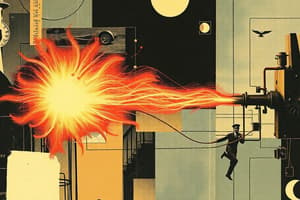Podcast
Questions and Answers
What is the unit of work done?
What is the unit of work done?
- Watt
- Joule (correct)
- Meter
- Newton
In the example of a dog pulling a sledge, what type of energy transfer occurs?
In the example of a dog pulling a sledge, what type of energy transfer occurs?
- Potential to electrical
- Kinetic to potential
- Chemical to thermal
- Chemical to kinetic (correct)
Which of the following is NOT a type of work mentioned?
Which of the following is NOT a type of work mentioned?
- Thermal work
- Electrical work
- Mechanical work
- Chemical work (correct)
What is the calculated work done when a force of 2,000 Newtons is applied to stop a car over a distance of 20 meters?
What is the calculated work done when a force of 2,000 Newtons is applied to stop a car over a distance of 20 meters?
What happens to the kinetic energy of a car when the brakes are applied?
What happens to the kinetic energy of a car when the brakes are applied?
Which of the following formulas accurately represents work done?
Which of the following formulas accurately represents work done?
Why is familiarity with the formula for work done important?
Why is familiarity with the formula for work done important?
Which of the following correctly describes how work is done in mechanical scenarios?
Which of the following correctly describes how work is done in mechanical scenarios?
Flashcards are hidden until you start studying
Study Notes
Definition of Work Done
- Work is done when energy is transferred from one energy store to another.
- Two main types of work are mechanical work and electrical work.
Mechanical Work
- Involves using a force to move an object.
- Example: A dog pulling a sledge demonstrates energy transfer from the chemical energy store of the dog to the kinetic energy store of the moving sledge.
- Friction between the sledge and the ground causes some kinetic energy to be lost to the thermal energy store.
Work Calculation
- Formula: Work done (in joules) = Force (in Newtons) × Distance (in meters).
- Example Calculation: A dog applies a force of 50 Newtons to move a sledge 3 meters.
- Calculation: ( 50 , \text{N} \times 3 , \text{m} = 150 , \text{J} ).
- Total energy transferred: 150 joules from the dog to the sledge and the ground.
Braking Example
- A car traveling at 20 m/s experiences work done when the brakes are applied.
- Kinetic energy of the moving car is converted to thermal energy due to friction in the brakes, leading to a decrease in speed until the car stops.
Work Done in Braking
- Example Problem: A force of 2,000 Newtons is applied to stop a car over 20 meters.
- Using the formula: ( 2000 , \text{N} \times 20 , \text{m} = 40,000 , \text{J} ).
- Final work done is 40,000 joules.
Key Takeaways
- Understanding the relationship between force, distance, and energy transfer is crucial for calculating work done.
- Familiarity with the formula for work done is essential as it will not be provided in examinations.
Definition of Work Done
- Work is the transfer of energy between energy stores.
- Two primary types of work: mechanical work and electrical work.
Mechanical Work
- Involves applying a force to move an object, converting energy types.
- Example: A dog pulling a sledge transfers energy from its chemical energy store to the kinetic energy store of the sledge.
- Friction during movement may cause energy loss to thermal energy store.
Work Calculation
- Formula for calculating work done: Work (joules) = Force (Newtons) × Distance (meters).
- Example: A dog exerts a force of 50 Newtons over a distance of 3 meters results in:
- Work done = ( 50 , \text{N} \times 3 , \text{m} = 150 , \text{J} ).
- Total energy transferred is 150 joules, affecting both the sledge and the ground.
Braking Example
- When brakes are applied, a car traveling at 20 m/s converts kinetic energy to thermal energy through friction, reducing speed until it stops.
Work Done in Braking
- Example scenario: A force of 2,000 Newtons is used to stop a car over 20 meters.
- Calculation using the work formula shows:
- Work done = ( 2000 , \text{N} \times 20 , \text{m} = 40,000 , \text{J} ).
- Total work done during braking is 40,000 joules.
Key Takeaways
- Grasping the relationship between force, distance, and energy transfer is critical for work calculations.
- Mastery of the work formula is essential for success, as it won't be provided during exams.
Studying That Suits You
Use AI to generate personalized quizzes and flashcards to suit your learning preferences.




